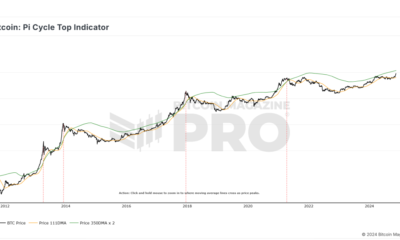Ethereum
Ethereum ETFs see $341.8m net outflows in first week, triggered by Grayscale’s ETHE
Published
4 months agoon
By
admin
U.S. spot Ethereum exchange-traded funds have had a mixed start this week, with net inflows into most ETFs overshadowed by significant net outflows from Grayscale’s converted fund, ETHE.
Data from Farside Investors shows that spot Ethereum (ETH) ETFs saw just over $162 million in total outflows on Friday, July 26, marking the third consecutive day of net negative flows. In contrast, spot Bitcoin (BTC) ETFs recorded $51.8 million in net inflows on the same day, continuing a trend of positive flows for three days straight.
The first ever spot Ethereum ETFs in the U.S. — nine products from eight issuers — started trading on Tuesday, July 23, following their approval by the Securities and Exchange Commission in May.
ETH ETFs’ first week
In the first week of trading, most of the newly launched Ethereum ETFs saw positive inflows, except for Grayscale’s ETHE, which experienced $1.51 billion in net outflows. ETHE’s outlfows have resulted in an overall weekly outflow of $341.8 million for the ETFs.
BlackRock’s ETHA led the pack in terms of inflows, generating $442 million worth of net inflows, followed by Bitwise’s ETHW with $265.9 million and Fidelity’s FETH with $219.4 million.
VanEck’s ETHV and Franklin Templeton’s EZET saw smaller inflows of $35.4 million and $23.3 million, respectively. 21Shares’s CETH received an inflow of $7.5 million only on launch day and saw zero inflows on the following three trading days.

Grayscale’s two Ethereum ETFs, explained
Major crypto asset manager Grayscale has introduced two spot Ethereum funds to the markets this past week, trading under the tickers ETHE and ETH. The Grayscale Ethereum Trust, ETHE, was initially launched in 2017 as a private placement, meaning it was only available to select investors and institutions in the U.S. Since 2019, the shares of the Ethereum Trust have been publicly traded OTC under the ticker ETHE. OTC trading of ETHE came with a 6-month holding period. However, since ETHE was converted to a spot Ethereum ETF last week, investors gained the ability to sell their holdings more freely.
The 2.5% management fee for ETHE — which is relatively quite high compared to fees of 0.25% or less from other ETF issuers — has driven investors to switch to competing products with lower fees, spurring the outflows from Grayscale’s fund. This situation is very much similar to what happened with Grayscale’s Bitcoin Trust (GBTC), which was also converted to a BTC ETF in January and then saw over $5 billion in outflows in its first month post-conversion.
Likely in expectation of this dynamic, Grayscale launched another ETF product this week, the Ethereum Mini Trust (under the ticker ETH). The new product boasts a competitive fee of 0.15%, positioning it as one of the most affordable spot Ethereum funds in the U.S. In contrast to ETHE, Grayscale’s Mini Trust saw inflows every trading day this past week, for a total of $164 million.
Grayscale’s ETHE, which held around $10 billion in assets (2.9 million ETH) before its conversion to an ETF, allocated $9.2 billion to its ETHE ETF product and just over $1 billion to its ETH fund.
The ETHE outflows, coupled with a more than 6% drop in the price of Ethereum since the ETFs launched, have reduced Grayscale Ethereum Trust’s assets under management to approximately $7.46 billion (2.28 million ETH), as reported on its fund page.
Ethereum ETFs vs Bitcoin ETFs: first week
It’s still early days, and if Grayscale’s spot Bitcoin ETF pattern is an indicator, the net outflows for ETHE might slow down. However, with an average net outflow of around $378 million per trading day this past week, ETHE’s assets could be depleted within a month.
In terms of the Grayscale effect, a significant difference between GBTC and ETHE is that GBTC shares were trading at a discount to the price of spot BTC when the GBTC ETF product launched. In contrast, ETHE’s “discount” — or the difference between the price of an ETHE share and the spot price of ETH — had closed by the time the spot Ethereum ETFs went live, partly explaining the stronger incentive to exit the fund.
Additionally, Bitcoin’s price had surged considerably before the spot Bitcoin ETFs launch in January, nearly doubling after approval expectations increased in October. In contrast, the price of Ethereum has been declining, falling more than 15% since the spot Ethereum ETFs were first approved on May 23.
“The major difference to me is the comparatively massive ETHE outflow. I think GBTC didn’t have that on day one because it was still at a meaningful discount when it launched,” noted James Seyffart, a Bloomberg ETF analyst, when comparing the outflows of the two products.
The the nine newly launched Ethereum ETFs saw total net inflows of $106.7 million on their first trading day, July 23, compared to $628 million in inflows for Bitcoin ETFs on their debut, according to data from SoSoValue
In terms of trading volume, the ETH ETFs saw around $1.1 billion in trades on their first day, while BTC ETFs saw $4.66 billion in trading volume on their inaugural day.
Throughout the first week, Ethereum ETFs generated a total trading volume of approximately $4.05 billion, compared to $7.85 billion for Bitcoin ETFs in their initial week.
Analysts anticipate that spot Ethereum ETFs will attract inflows ranging from 6% to 48% of those seen by Bitcoin ETFs in the first six months. This estimate suggests total inflows into Ethereum ETFs could reach between $1 trillion and $7.5 trillion by late January 2025.
At the time of writing, ETH, the second-largest cryptocurrency, was trading at $3,280. Its market cap is around $393 billion, with a 24-hour trading volume near $14.4 billion.
Source link
You may like


How Viable Are BitVM Based Pegs?


UK Government to Draft a Regulatory Framework for Crypto, Stablecoins, Staking in Early 2025


Bitcoin Cash eyes 18% rally


Rare Shiba Inu Price Patterns Hint SHIB Could Double Soon


The Bitcoin Pi Cycle Top Indicator: How to Accurately Time Market Cycle Peaks


Bitcoin Approaches $100K; Retail Investors Stay Steady
ETH
Ethereum Believers May Be Staring Down Opportunity As ETH Reaches Another Low Against Bitcoin: CryptoQuant CEO
Published
10 hours agoon
November 22, 2024By
admin
Believers in Ethereum (ETH) could be on the verge of an opportunity, according to Ki Young Ju, the founder and chief executive of the digital asset analytics firm CryptoQuant.
Young Ju tells his 370,400 followers on the social media platform X that the ETH/Bitcoin (BTC) Net Unrealized Profit/Loss level just hit a four-year low.
“Despite Ethereum’s underperformance against Bitcoin, ETH holders endure losses without realizing them. This mirrors levels from its early 2020 bottom.
This might be an opportunity for ETH believers.”

Young Ju also notes that ETH is becoming less correlated with BTC.
“The 180-day BTC-ETH Pearson correlation is at a three-year low. A 10% rise in Bitcoin could result in only a 3% gain for Ethereum.
Just because BTC is strong doesn’t mean you should buy ETH. Each asset is now following its own path.”

Young Ju isn’t the only crypto analyst who’s bullish on Ethereum: Former Goldman Sachs executive Raoul Pal also thinks ETH is primed for big gains.
The Real Vision CEO says ETH’s current chart is playing out similarly to Bitcoin’s between 2011 and 2019.
“Ethereum now versus the previous periods is following the last in Bitcoin. Now whether it gets to the target here of $20,000/ETH, who knows. Doesn’t really matter. But directionally, we’ll see what happens. ETH should accelerate from here, and I’m pretty confident that it will.”
ETH is trading at $3,054 at time of writing. The second-ranked crypto asset by market cap is down more than 1% in the past 24 hours.
Don’t Miss a Beat – Subscribe to get email alerts delivered directly to your inbox
Check Price Action
Follow us on X, Facebook and Telegram
Surf The Daily Hodl Mix
 

Disclaimer: Opinions expressed at The Daily Hodl are not investment advice. Investors should do their due diligence before making any high-risk investments in Bitcoin, cryptocurrency or digital assets. Please be advised that your transfers and trades are at your own risk, and any losses you may incur are your responsibility. The Daily Hodl does not recommend the buying or selling of any cryptocurrencies or digital assets, nor is The Daily Hodl an investment advisor. Please note that The Daily Hodl participates in affiliate marketing.
Generated Image: Midjourney
Source link
Bitcoin
Franklin Templeton crypto index ETF delayed by SEC
Published
2 days agoon
November 20, 2024By
admin

Franklin Templeton, one of the crypto exchange-traded fund (ETF) issuers, has expressed interest in releasing the crypto index ETF, but the authorities are now delaying it.
The Securities and Exchange Commission (SEC) detained the deadline for approving the crypto index ETF by Franklin Templeton. According to the filing on Nov. 20, the authorities raised their concern about the sufficient time they needed to decide whether it would be accepted or declined.
“The Commission may designate if it finds such longer period to be appropriate and publishes its reasons for so finding or as to which the self-regulatory organization consents, the Commission shall either approve the proposed rule change, disapprove the proposed rule change, or institute proceedings to determine whether the proposed rule change should be disapproved,” SEC fillings.
On August. 17, based on their filing, Franklin proposed the crypto index ETF by holding Bitcoin (BTC) and Ethereum (ETH) with the ticker EZPZ. The proposed fund would allow the two most prominent crypto in the world under the same index with an unspecified ratio weighted by market capitalization.
If approved by the authorities, EZPZ would use the Coinbase custody and be listed on the Cboe BZX exchange. Franklin may add another crypto into the index but should gain approval from the SEC.
Franklin Templeton moves on crypto
Franklin Templeton, which is based in New York, is one of the most adaptable asset managers that allows investors to gain more exposure from the crypto price movement. Franklin created another crypto-related product after receiving the authority approval in January for Bitcoin spot ETF.
On October. 31, they tokenized money market funds into several blockchains, including Base, Arbitrum, Polygon, Avalanche, Aptos, and Stellar. The U.S. government money market fund (FOBXX) has $410 million in assets being tokenized into that blockchain.
Franklin also works with SBI Group in Japan to prepare for the possibility of accepting the crypto fund in the country, but this work’s development has not been published yet.
Source link
Bitcoin
Crypto product record major inflow up to $2.2 billion
Published
3 days agoon
November 19, 2024By
admin

CoinShares, a digital asset manager, reported that last week crypto products saw a major inflow from institutional investors of up to $2.2 billion.
The latest U.S. Election, on Nov. 5, still stimulated the weekly cryptocurrency inflow up to $2.2 billion. The number increased 15% from the previous week by about $1.98 billion.
According to CoinShares’s release, on Nov. 18, digital asset inflows recorded $33.5 billion year-to-date and hit a new peak of under-asset management (AUM) up to $138 billion.
Bitcoin (BTC) saw the largest inflow based on assets last week of around $1.48 billion or equal to 67%. Followed by Ethereum (ETH) and Solana (SOL) with inflows $646 million and $23.9 million respectively.
The Beam Chain network upgrade proposal by Justin Drake has increased Ethereum’s inflow from $157 million. Only multi-asset and Binance Coin (BNB) record a week’s outflow.
BlackRock’s iShares Bitcoin Trust ETF (IBIT) recorded the highest surge in crypto product from last week’s inflow up to 63% or up to $2.1 billion. While the rest of the funding recorded an outflow ranging from $8 million to $153 million, including Grayscale and Fidelity.
Crypto product driving factor: U.S. Election
James Butterfill, CoinShares head of research, says a combination of looser monetary policy and a Republican winning a majority of the Congress and Presidency appears to be a driving factor of these inflows.
Donald Trump winning the White House’s second term still brings a positive rally for the cryptocurrency industry, as well as the crypto product. Buterfill has mentioned that Trump’s presidency would bring crypto-friendly regulations and fiscal policy.
Earlier, Trump picked several names for secretary on his cabinet who identified as pro-crypto personalities including Elon Musk, Tom Emmer, and Robert F. Kennedy Jr.
Bitcoin Act, who were proposed by Republican Senator Cynthia Lummis, and the Bitcoin Strategic Reserve also boosts the crypto investor’s confidence. He also mentioned this favorable outlook may bring the best potential of Bitcoin in the future.
“The next four years may witness an unprecedented level of institutional support, increased government interest, and broader public adoption, setting the stage for Bitcoin to further solidify its place in the global financial landscape,” Buterfill mentioned in the other report.
Source link

How Viable Are BitVM Based Pegs?

UK Government to Draft a Regulatory Framework for Crypto, Stablecoins, Staking in Early 2025

Bitcoin Cash eyes 18% rally

Rare Shiba Inu Price Patterns Hint SHIB Could Double Soon

The Bitcoin Pi Cycle Top Indicator: How to Accurately Time Market Cycle Peaks
Bitcoin Breakout At $93,257 Barrier Fuels Bullish Optimism

Bitcoin Approaches $100K; Retail Investors Stay Steady

Solana Hits New ATH On Huge Whale Accumulation, More Gains Ahead?

Microsoft Should Buy $78 Billion Worth of Bitcoin

Ethereum Believers May Be Staring Down Opportunity As ETH Reaches Another Low Against Bitcoin: CryptoQuant CEO

UK government is ready for crypto regulations next year

“Crypto Dad” Chris Giancarlo Emerges Top For White House Crypto Czar Role

Bitcoin Nears $100,000 As Trump Council Expected To Implement BTC Reserve

Know Your Missiles: Russia’s Experimental Hypersonic Missile Is A New Kind of Killing Machine

Polkadot investor predicts a 30,000% rally for this $0.04 token by 2025
182267361726451435

Top Crypto News Headlines of The Week

Why Did Trump Change His Mind on Bitcoin?

New U.S. president must bring clarity to crypto regulation, analyst says

Ethereum, Solana touch key levels as Bitcoin spikes

Bitcoin Open-Source Development Takes The Stage In Nashville

Will XRP Price Defend $0.5 Support If SEC Decides to Appeal?

Bitcoin 20% Surge In 3 Weeks Teases Record-Breaking Potential

Ethereum Crash A Buying Opportunity? This Whale Thinks So

Shiba Inu Price Slips 4% as 3500% Burn Rate Surge Fails to Halt Correction

‘Hamster Kombat’ Airdrop Delayed as Pre-Market Trading for Telegram Game Expands

Washington financial watchdog warns of scam involving fake crypto ‘professors’

Citigroup Executive Steps Down To Explore Crypto
Mostbet Güvenilir Mi – Casino Bonus 2024

Bitcoin flashes indicator that often precedes higher prices: CryptoQuant
Trending

 2 months ago
2 months ago182267361726451435

 24/7 Cryptocurrency News3 months ago
24/7 Cryptocurrency News3 months agoTop Crypto News Headlines of The Week

 Donald Trump4 months ago
Donald Trump4 months agoWhy Did Trump Change His Mind on Bitcoin?

 News3 months ago
News3 months agoNew U.S. president must bring clarity to crypto regulation, analyst says

 Bitcoin4 months ago
Bitcoin4 months agoEthereum, Solana touch key levels as Bitcoin spikes

 Opinion4 months ago
Opinion4 months agoBitcoin Open-Source Development Takes The Stage In Nashville

 Price analysis3 months ago
Price analysis3 months agoWill XRP Price Defend $0.5 Support If SEC Decides to Appeal?

 Bitcoin4 months ago
Bitcoin4 months agoBitcoin 20% Surge In 3 Weeks Teases Record-Breaking Potential


